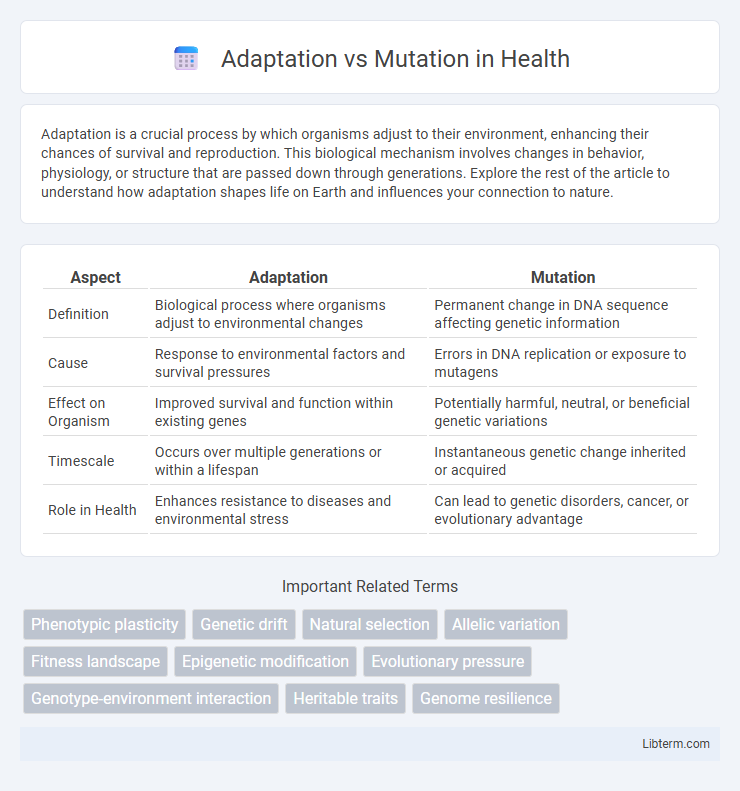Adaptation is a crucial process by which organisms adjust to their environment, enhancing their chances of survival and reproduction. This biological mechanism involves changes in behavior, physiology, or structure that are passed down through generations. Explore the rest of the article to understand how adaptation shapes life on Earth and influences your connection to nature.
Table of Comparison
| Aspect | Adaptation | Mutation |
|---|---|---|
| Definition | Biological process where organisms adjust to environmental changes | Permanent change in DNA sequence affecting genetic information |
| Cause | Response to environmental factors and survival pressures | Errors in DNA replication or exposure to mutagens |
| Effect on Organism | Improved survival and function within existing genes | Potentially harmful, neutral, or beneficial genetic variations |
| Timescale | Occurs over multiple generations or within a lifespan | Instantaneous genetic change inherited or acquired |
| Role in Health | Enhances resistance to diseases and environmental stress | Can lead to genetic disorders, cancer, or evolutionary advantage |
Introduction: Understanding Adaptation and Mutation
Adaptation refers to heritable traits that enhance an organism's survival and reproduction in specific environments, shaped by natural selection over generations. Mutation involves random changes in DNA sequences that can introduce genetic variation, sometimes resulting in new traits. Understanding the interplay between adaptation and mutation is essential for studying evolutionary processes and biodiversity.
Defining Adaptation in Biological Context
Adaptation in a biological context refers to the process by which organisms develop traits that enhance their survival and reproductive success in specific environments through natural selection. These heritable characteristics arise gradually over generations, allowing populations to thrive under changing ecological pressures. Unlike mutations, which are random genetic changes, adaptations result from selective pressures favoring beneficial traits.
Mutation: The Source of Genetic Variation
Mutation serves as the primary source of genetic variation by introducing random changes in an organism's DNA sequence, which can result in new traits or characteristics. These alterations can occur through various mechanisms such as point mutations, insertions, deletions, and chromosomal rearrangements, significantly impacting evolutionary processes. Genetic variation from mutations fuels natural selection by providing diverse alleles that enhance a population's ability to adapt to changing environments.
Mechanisms of Adaptation in Organisms
Organisms adapt through mechanisms such as genetic variation, natural selection, and phenotypic plasticity, which enable populations to survive environmental changes. Genetic variation arises from mutations, gene flow, and recombination, providing the raw material for adaptation. Phenotypic plasticity allows individual organisms to adjust their physiology or behavior in response to environmental stimuli without altering their genetic code.
Types and Causes of Mutations
Mutations can be classified into several types, including point mutations, insertions, deletions, and frameshift mutations, each altering the genetic code in distinct ways. Causes of mutations range from spontaneous errors during DNA replication, exposure to mutagenic chemicals, ultraviolet radiation, to viral infections that insert genetic material into host genomes. Understanding these mutation types and causes is essential for studying genetic variation and the potential for adaptation in populations.
Role of Mutation in Evolutionary Processes
Mutation serves as the primary source of genetic variation essential for evolutionary processes, introducing new alleles into a population's gene pool. These random changes in DNA sequences can result in novel traits that may enhance an organism's survival or reproductive success in changing environments. Natural selection then acts on this variation, favoring advantageous mutations that drive adaptation and speciation over successive generations.
How Adaptations Arise from Mutations
Adaptations arise from mutations as genetic variations provide the raw material for natural selection, leading to traits that enhance survival and reproduction in specific environments. Mutations introduce new alleles by altering DNA sequences, which can result in phenotypic changes that may be beneficial, neutral, or deleterious. Over generations, beneficial mutations accumulate, increasing an organism's fitness and driving evolutionary adaptation in populations.
Key Differences Between Adaptation and Mutation
Adaptation involves gradual, beneficial changes in organisms that enhance survival and reproduction within specific environments, often driven by natural selection. Mutation refers to random alterations in an organism's DNA sequence that can be harmful, neutral, or occasionally advantageous, serving as the raw genetic material for evolution. Adaptations are phenotypic traits shaped over generations, whereas mutations are specific genetic events that may initiate or contribute to these adaptive changes.
Real-World Examples: Adaptation vs Mutation
Adaptation occurs when organisms develop traits that enhance survival in their environment, such as the peppered moth's color change during the Industrial Revolution, which improved camouflage. Mutation involves random genetic changes, like the CCR5-D32 mutation in humans, providing resistance to HIV infection. Unlike mutations, adaptations result from natural selection favoring beneficial traits over generations.
Conclusion: Impact on Species Survival and Diversity
Adaptation enhances species survival by enabling organisms to adjust traits suited to environmental changes, promoting long-term stability and increasing biodiversity. Mutation generates genetic variation, fueling evolutionary processes that can lead to new adaptations or species emergence. Together, adaptation and mutation drive evolutionary resilience, balancing survival and diversity within ecosystems.
Adaptation Infographic

 libterm.com
libterm.com